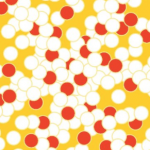 Salt-doped block polymers and ionic liquids—it’s a thermodynamic party. Better physics simulations crank up the possibilities for new composite materials.
Salt-doped block polymers and ionic liquids—it’s a thermodynamic party. Better physics simulations crank up the possibilities for new composite materials.
Issei Nakamura is a theoretical physicist bringing a reality check to soft materials development. Specifically, he models the complex interactions of ionic liquids and block polymers, which together create salt-doped block polymers.
The ionic liquid squishes in between all the loops and strands of the block polymer. Because an ionic liquid can assemble a block polymer into millions of structures with wide-ranging properties, the possibilities are nearly endless. The composite materials show promise for battery electrodes, fuel cell membranes, electrochemical sensors and even artificial muscles.
The catch is that the materials have to get their thermodynamic groove figured out. Right now, untwining the conditions and properties of all those possible structures is like learning to tango blindfolded. Researchers and engineers can go through the motions, but understanding the sequence, the steps—and why—requires a new way to look at the system. And that’s where Nakamura steps in. Read the full story in Unscripted.